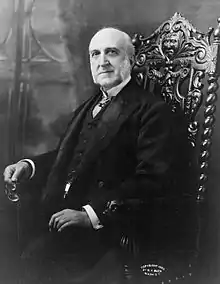1910 and 1911 United States Senate elections
Although the 17th Amendment was not passed until 1913, some states elected their senators directly before its passage. Oregon pioneered direct election and experimented with different measures over several years until it succeeded in 1907. Soon after, Nebraska followed suit and laid the foundation for other states to adopt measures reflecting the people's will. By 1912, as many as 29 states elected senators either as nominees of their party's primary or in conjunction with a general election.
| ||||||||||||||||||||||||||||
34 of the 92 seats in the United States Senate 47 seats needed for a majority | ||||||||||||||||||||||||||||
|---|---|---|---|---|---|---|---|---|---|---|---|---|---|---|---|---|---|---|---|---|---|---|---|---|---|---|---|---|
| ||||||||||||||||||||||||||||
| ||||||||||||||||||||||||||||
Results
Senate Party Division, 62nd Congress (1911–1913):
- Majority Party: Republican (50 seats)
- Minority Party: Democratic (40 seats)
- Other Parties: 0
- Vacant: 2
- Total Seats: 92
Four seats were added in early 1912 for new states: Arizona (which elected 2 Democrats) and New Mexico (which elected 2 Republicans).
Change in composition
Before the elections
At the beginning of 1910.
| D1 | D2 | D3 | D4 | D5 | D6 | ||||
| D16 | D15 | D14 | D13 | D12 | D11 | D10 | D9 | D8 | D7 |
| D17 | D18 | D19 | D20 | D21 | D22 | D23 | D24 Ala. Ran |
D25 Fla. Ran |
D26 La. (sp) Ran |
| R57 W.Va. (reg) Ran |
R58 Wis. Ran |
R59 Wyo. Ran |
D33 Va. Ran |
D32 Texas Ran |
D31 Tenn. Ran |
D30 N.D. (sp) Ran |
D29 Miss. (sp) Retired |
D28 Miss. (reg) Ran |
D27 Md. Ran |
| R56 W.Va. (sp) Retired |
R55 Wash. Retired |
R54 Vt. Ran |
R53 Utah Ran |
R52 R.I. Retired |
R51 Pa. Ran |
R50 Ohio Ran |
R49 N.D. (reg) Ran |
R48 N.Y. Ran |
R47 N.J. Ran |
| Majority → | |||||||||
| R37 Del. Ran |
R38 Ind. Ran |
R39 Maine Ran |
R40 Mass. Ran |
R41 Mich. Ran |
R42 Minn. Ran |
R43 Mo. Retired |
R44 Mont. Retired |
R45 Neb. Ran |
R46 Nev. Ran |
| R36 Conn. Ran |
R35 Calif. Retired |
R34 | R33 | R32 | R31 | R30 | R29 | R28 | R27 |
| R17 | R18 | R19 | R20 | R21 | R22 | R23 | R24 | R25 | R26 |
| R16 | R15 | R14 | R13 | R12 | R11 | R10 | R9 | R8 | R7 |
| R1 | R2 | R3 | R4 | R5 | R6 | ||||
Elections results
| D1 | D2 | D3 | D4 | D5 | D6 | ||||
| D16 | D15 | D14 | D13 | D12 | D11 | D10 | D9 | D8 | D7 |
| D17 | D18 | D19 | D20 | D21 | D22 | D23 | D24 Ala. Re-elected |
D25 Ind. Gain |
D26 La. (sp) Elected[lower-alpha 3] |
| D36 Tenn. Hold |
D35 Ohio Gain |
D34 N.J. Gain |
D33 Neb. Gain |
D32 Mont. Gain |
D31 Mo. Gain |
D30 Miss. (sp) Hold |
D29 Miss. (reg) Hold |
D28 Md. Re-elected |
D27 Maine Gain |
| D37 Texas Re-elected |
D38 Va. Re-elected |
D39 W.Va. (reg) Gain |
D40 W.Va. (sp) Gain |
V1 Fla. D Loss |
V2 N.Y. R Loss |
R51 Wyo. Re-elected |
R50 Wis. Re-elected |
R49 Wash. Hold |
R48 Vt. Re-elected |
| Majority → | |||||||||
| R37 Del. Re-elected |
R38 Mass. Re-elected |
R39 Mich. Hold |
R40 Minn. Re-elected |
R41 Nev. Re-elected |
R42 N.D. (reg) Re-elected |
R43 N.D. (sp) Gain |
R44 Pa. Re-elected |
R45 R.I. Hold |
R46 Utah Re-elected |
| R36 Conn. Hold |
R35 Calif. Hold |
R34 | R33 | R32 | R31 | R30 | R29 | R28 | R27 |
| R17 | R18 | R19 | R20 | R21 | R22 | R23 | R24 | R25 | R26 |
| R16 | R15 | R14 | R13 | R12 | R11 | R10 | R9 | R8 | R7 |
| R1 | R2 | R3 | R4 | R5 | R6 | ||||
Beginning of the next Congress
| D1 | D2 | D3 | D4 | D5 | D6 | ||||
| D16 | D15 | D14 | D13 | D12 | D11 | D10 | D9 | D8 | D7 |
| D17 | D18 | D19 | D20 | D21 | D22 | D23 | D24 | D25 | D26 |
| D36 | D35 | D34 | D33 | D32 | D31 | D30 | D29 | D28 | D27 |
| D37 | D38 | D39 | D40 Fla. Appointed |
V1 Colo. D Loss[lower-alpha 4] |
V2 | R50 | R49 | R48 | R47 |
| Majority → | R46 | ||||||||
| R37 | R38 | R39 | R40 | R41 | R42 | R43 | R44 | R45 | |
| R36 | R35 | R34 | R33 | R32 | R31 | R30 | R29 | R28 | R27 |
| R17 | R18 | R19 | R20 | R21 | R22 | R23 | R24 | R25 | R26 |
| R16 | R15 | R14 | R13 | R12 | R11 | R10 | R9 | R8 | R7 |
| R1 | R2 | R3 | R4 | R5 | R6 | ||||
| Key |
|
|---|
Race summaries
Special elections during the 61st Congress
In these elections, the winners were seated during 1910 or in 1911 before March 4; ordered by election date.
| State | Incumbent | Results | Candidates | ||
|---|---|---|---|---|---|
| Senator | Party | Electoral history | |||
| Mississippi (Class 2) |
James Gordon | Democratic | 1909 (Appointed) | Interim appointee retired. New senator elected February 23, 1910.[1] Democratic hold. |
|
| Louisiana (Class 3) |
John Thornton | Democratic | 1910 (Appointed) | Interim appointee elected December 6, 1910.[2] |
|
| North Dakota (Class 3) |
William E. Purcell | Democratic | 1910 (Appointed) | Interim appointee lost election. New senator elected January 17, 1911. Republican gain. Winner took office February 11, 1911 upon resigning from the U.S. House. |
|
| West Virginia (Class 2) |
Davis Elkins | Republican | 1910 (Appointed) | Interim appointee lost election. New senator elected February 1, 1911. Democratic gain. |
|
In this election, the winner were seated in the 63rd Congress, starting March 4, 1913.
| State | Incumbent | Results | Candidates | ||
|---|---|---|---|---|---|
| Senator | Party | Electoral history | |||
| Alabama | John H. Bankhead | Democratic | 1907 (Appointed) 1907 (Special) |
Incumbent re-elected early January 17, 1911, for the term beginning March 4, 1913. |
|
Races leading to the 62nd Congress
In these general elections, the winners were elected for the term beginning March 4, 1911; ordered by state.
All of the elections involved the Class 1 seats.
| State | Incumbent | Results | Candidates | ||
|---|---|---|---|---|---|
| Senator | Party | Electoral history | |||
| California | Frank P. Flint | Republican | 1905 | Incumbent retired. New senator elected January 10, 1911.[7] Republican hold. |
|
| Connecticut | Morgan Bulkeley | Republican | 1905 | Incumbent lost renomination and re-election. New senator elected January 17, 1911.[7] Republican hold. |
|
| Delaware | Henry A. du Pont | Republican | 1906 | Incumbent re-elected January 25, 1911.[8] |
|
| Florida | James Taliaferro | Democratic | 1899 (Special) 1905 (Appointed) 1905 (Special) |
Incumbent lost re-election. Legislature failed to elect. Democratic loss. New senator was appointed to begin the term. |
Nathan P. Bryan (Democratic)[9] |
| Indiana | Albert J. Beveridge | Republican | 1899 1905 |
Incumbent lost re-election. New senator elected January 17, 1911.[7] Democratic gain. |
|
| Maine | Eugene Hale | Republican | 1881 1887 1893 1899 1905 |
Incumbent retired. New senator elected January 17, 1911.[7] Democratic gain. |
|
| Maryland | Isidor Rayner | Democratic | 1904 | Incumbent re-elected January 18, 1910.[7] |
|
| Massachusetts | Henry Cabot Lodge | Republican | 1893 1899 1905 |
Incumbent re-elected January 18, 1911.[7][12] |
|
| Michigan | Julius C. Burrows | Republican | 1895 (Special) 1899 1905 |
Incumbent lost renomination. New senator elected January 17, 1911.[7] Republican hold. |
|
| Minnesota | Moses E. Clapp | Republican | 1901 (Special) 1905 |
Incumbent re-elected January 17, 1911.[7] |
|
| Mississippi | Hernando Money | Democratic | 1897 (Appointed) 1899 1904 |
Incumbent retired. New senator elected early January 21, 1908.[14] Democratic hold. |
|
| Missouri | William Warner | Republican | 1905 | Incumbent retired. New senator elected January 17, 1911.[7] Democratic gain. |
|
| Montana | Thomas H. Carter | Republican | 1895 1901 (Lost) 1905 |
Incumbent retired. New senator elected March 2, 1911. Democratic gain. |
|
| Nebraska | Elmer Burkett | Republican | 1905 | Incumbent lost re-election. New senator elected January 17, 1911, ratifying the popular selection made in 1910 state elections.[7][4] Democratic gain. |
|
| Nevada | George S. Nixon | Republican | 1905 | Incumbent re-elected January 24, 1911, ratifying the popular selection made in 1910 state elections.[7] |
|
| New Jersey | John Kean | Republican | 1899 1905 |
Incumbent retired. New senator elected January 25, 1911.[7] Democratic gain. |
|
| New York | Chauncey Depew | Republican | 1899 1905 |
Incumbent ran for re-election, but legislature failed to elect. Republican loss. A new senator was elected late, see below. |
Chauncey Depew (Republican) William F. Sheehan (Democratic, Tammany faction) Others, see below |
| North Dakota | Porter J. McCumber | Republican | 1899 1905 |
Incumbent re-elected January 17, 1911.[7] |
|
| Ohio | Charles W. F. Dick | Republican | 1904 (Special) 1904 |
Incumbent lost re-election. New senator elected January 10, 1911. Democratic gain. |
|
| Pennsylvania | George T. Oliver | Republican | 1909 (Special) | Incumbent re-elected January 11, 1911.[7] |
|
| Rhode Island | Nelson W. Aldrich | Republican | 1881 (Special) 1886 1892 1898 1905 |
Incumbent retired. New senator elected January 18, 1911. Republican hold. |
|
| Tennessee | James B. Frazier | Democratic | 1905 (Special) | Incumbent lost re-election. New senator elected January 23, 1911. Democratic hold. |
|
| Texas | Charles Allen Culberson | Democratic | 1899 1905 |
Incumbent re-elected January 24, 1911. |
|
| Utah | George Sutherland | Republican | 1905 | Incumbent re-elected January 17, 1911. |
|
| Vermont | Carroll S. Page | Republican | 1908 (Special) | Incumbent re-elected October 18, 1910. |
|
| Virginia | John W. Daniel | Democratic | 1887 1893 1899 1904 |
Incumbent re-elected January 25, 1910. Incumbent died June 29, 1910. A new senator was appointed to finish the term, and reappointed to begin the new term. The new senator was subsequently elected to finish the new term.[19] |
|
| Washington | Samuel H. Piles | Republican | 1905 | Incumbent retired. New senator elected January 17, 1911.[7][5] Republican hold. |
|
| West Virginia | Nathan B. Scott | Republican | 1899 1905 |
Incumbent lost re-election. New senator elected February 1, 1911.[7][5] Democratic gain. |
|
| Wisconsin | Robert M. La Follette | Republican | 1905 | Incumbent re-elected January 24, 1911.[7][5] |
|
| Wyoming | Clarence D. Clark | Republican | 1905 | Incumbent re-elected January 24, 1911.[7][5] |
|
Elections during the 62nd Congress
In these elections, the winners were elected in 1911 after March 4; ordered by date.
| State | Incumbent | Results | Candidates | ||
|---|---|---|---|---|---|
| Senator | Party | Electoral history | |||
| New York (Class 1) |
Vacant | Legislature had failed to elect, see above. New senator elected late March 31, 1911 on the sixty-fourth ballot. Democratic gain. |
| ||
| Iowa (Class 2) |
Lafayette Young | Republican | 1911 (Appointed) | Interim appointee lost election to finish the term. New senator elected April 12, 1911. Republican hold. |
|
| Florida (Class 1) |
Nathan P. Bryan | Democratic | 1911 (Appointed) | Interim appointee elected late April 18, 1911. |
|
| Georgia (Class 3) |
Joseph M. Terrell | Democratic | 1910 (Appointed) | Interim appointee lost election. New senator elected July 12, 1911. Democratic hold. |
|
Alabama

Democrat John H. Bankhead was re-elected early January 17, 1911[6] for the 1913 term.
California
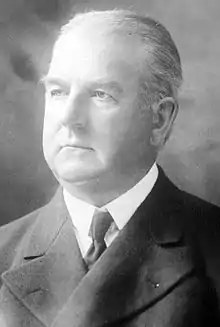
Republican incumbent Frank P. Flint, who had been elected in 1905, retired. Republican John D. Works received a plurality of votes cast at a Republican state primary. Republican A. G. Spalding, however, carried a majority of the legislative districts represented by Republicans.[6] In the legislature, Works was elected January 10, 1911 with 92 votes over Spalding's 21 votes, and a scattering of votes for various Democrats.[7][6]
Connecticut
.jpg.webp)
Republican incumbent Morgan Bulkeley, who had been elected in 1905, lost renomination in a Republican legislative caucus 113–64 to George P. McLean.
McLean was then elected January 17, 1911, with 177 votes to Democrat Homer Stille Cummings's 110 votes.[7][6]
Delaware
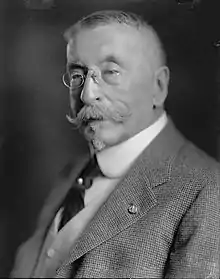
First-term Republican Henry A. du Pont was re-elected January 25, 1911.[8] He beat Democrat Willard Saulsbury Jr..
 Henry A. du Pont (Republican) 31 votes
Henry A. du Pont (Republican) 31 votes- Willard Saulsbury Jr. (Democratic) 21 votes[6]
Saulsbury would be elected in 1913 to the other Delaware senate seat. Du Pont would lose re-election in 1916, the first popular Senate election in Delaware.
Florida
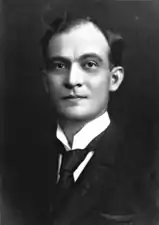
In June 1910, incumbent Democrat James Taliaferro lost a non-binding primary to former Governor Napoleon B. Broward for the term which started on March 4, 1911.[21] Broward died in October.[22] In early February 1911, Nathan P. Bryan won a non-binding primary for the seat, defeating William A. Blount 19,991 to 19,381.[23] The governor then appointed Bryan to fill the vacancy.[24]
In April 1911, the Florida Legislature unanimously elected Bryan to the remainder of the term.[25]
Georgia (Special)
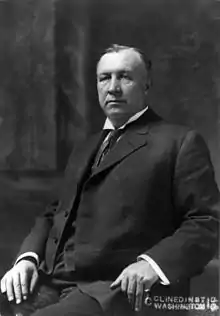
Three-term Democrat Alexander S. Clay died November 13, 1910 and Democratic former-Governor of Georgia Joseph M. Terrell was appointed November 17, 1910 to continue the term, pending a special election.
Democratic Governor of Georgia M. Hoke Smith won the July 12, 1911 special election to finish the term that would end in 1915.
 M. Hoke Smith (Democratic) 155 votes
M. Hoke Smith (Democratic) 155 votes- Joseph M. Terrell (Democratic) 51 votes
- W.A. Covington (Democratic) 6 votes
- Thomas E. Watson 7 votes
- John M. Holder (Democratic) 1 vote[10]
Smith had just begun his gubernatorial term July 1, 1911 when he was elected to the Senate. Although formally elected and qualified, Smith chose not to take office until November 16, 1911 so he could continue being Governor of Georgia.[26]
Smith would later be re-elected in 1914 and would serve through 1921.
Indiana
Iowa (Special)
Louisiana (Special)
Maine
Maryland
Massachusetts
Michigan
Minnesota
Mississippi
Mississippi (Regular)

Three-term Democrat Hernando Money retired from the class 1 seat. In 1908 the Mississippi legislature had already unanimously elected Democratic congressman John Sharp Williams early for the next term.[14]
Mississippi (Special)
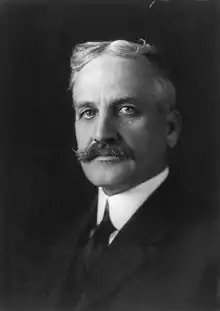
Three-term Democrat Anselm J. McLaurin died December 22, 1909 and Democrat James Gordon was appointed December 27, 1909 to continue the term pending a special election, in which he was not a candidate. The day after his appointment to the class 2 seat, he was identified as a former fugitive who had been sought as a suspect in the conspiracy to assassinate President Abraham Lincoln. Gordon was listed in 1865 by the United States government as a fugitive, and a reward of $10,000 had been offered for his capture, dead or alive. Later that year, he was ruled out of the suspects.[27] Gordon then admitted that he had met with John Wilkes Booth in Montreal in March 1865, and had discussed plans to kidnap Lincoln, but denied any discussion of murder.[28]
A plurality of legislators backed the white supremacist James K. Vardaman, but the fractured remainder sought to thwart his extreme racial policies. A majority united behind Percy to block Vardaman, instead electing Democrat LeRoy Percy February 23, 1910 to finish the term that would end in 1913.[1]
Percy would later lose renomination in 1912 to the next term.
Missouri
Montana
Democrat Henry L. Myers was elected on the 80th joint ballot by the Montana state legislature, winning 53 votes to incumbent Republican Thomas H. Carter's 45. Carter had led on the first ballot with 31 votes to Democrat Thomas J. Walsh's 28.
Nebraska
Nevada
New Jersey
New York
| |||||||||||||||||
201 members of the New York Assembly 101 votes needed to win | |||||||||||||||||
|---|---|---|---|---|---|---|---|---|---|---|---|---|---|---|---|---|---|
| |||||||||||||||||
| |||||||||||||||||
Republican incumbent Chauncey M. Depew had been re-elected to this seat in 1905, and his term would expire on March 3, 1911. At the State election in November 1910, John Alden Dix was elected Governor, the first Democrat to hold the position since 1894. Democrats also unexpectedly carried the state legislative elections, and Democrats also unexpectedly carried the state legislative electionscontrolled both the Senate and the Assembly. The 134th New York State Legislature met from January 4 to October 6, 1911, in Albany, New York. Democratic Ex-Lieutenant Governor William F. Sheehan announced his candidacy on December 30, 1910. Before the State election, when a Democratic victory seemed to be improbable, Sheehan had made an agreement with Tammany Hall leader Charles Francis Murphy that the Tammany men would support Sheehan for the U.S. Senate. The Democratic caucus met on January 16 and nominated Sheehan over Edward M. Shepard and D. Cady Herrick. The Republican caucus met on January 16 and re-nominated Chauncey M. Depew unanimously.
From January 17 through March 3, the legislature was deadlocked through 39 ballots, with anti-Tammany Democrats refusing to support Sheehan. On March 3, 1911 Depew's term ended.
The deadlock continued over another 19 ballots despite the vacant seat. Democrats then held a new caucus and nominated James A. O'Gorman, a justice of the New York Supreme Court. O'Gorman was elected over Depew on March 31, 1911.
| Candidate | Party | 64th joint ballot Mar 31 |
|---|---|---|
| Chauncey M. Depew | Republican | 80 |
| Democratic |
North Dakota
North Dakota (Special)
.jpg.webp)
North Dakota (Regular)

Ohio
Pennsylvania

The Pennsylvania election was held January 17, 1911. Incumbent George T. Oliver was re-elected by the Pennsylvania General Assembly.[29]
| Party | Candidate | Votes | % | |
|---|---|---|---|---|
| Republican | George T. Oliver (Incumbent) | 181 | 70.43% | |
| Democratic | J. Henry Cochran | 35 | 13.62% | |
| Democratic | Julian Kennedy | 25 | 9.73% | |
| Democratic | James B. Riley | 3 | 1.17% | |
| Republican | William Flinn | 2 | 0.78% | |
| Democratic | William H. Berry | 1 | 0.39% | |
| Democratic | George W. Guthrie | 1 | 0.39% | |
| Socialist | Joseph E. Cohen | 1 | 0.39% | |
| N/A | Not voting | 8 | 3.11% | |
| Total votes | 257 | 100% | ||
Rhode Island
Tennessee
Texas
Utah
Vermont
Virginia
Washington
West Virginia
West Virginia (Regular)

West Virginia (Special)

Wisconsin
Wyoming
See also
Notes
- as Republican Conference Chairman
- as Democratic Conference Chairman)
- Appointee elected
- Charles J. Hughes Jr. (D-Colorado) died January 11, 1911 and the seat was vacant until the January 15, 1913 election of Democrat Charles S. Thomas.
References
- "VARDAMAN'S DEFEAT RELIEF TO SENATORS". The New York Times. February 24, 1910. p. 4.
- "THORNTON CHOSEN SENATOR". The New York Times. December 7, 1910. p. 1.
- United States Senators Chosen, 1910, p. 439.
- United States Senators Chosen, 1911, p. 457.
- United States Senators Chosen, 1911, p. 458.
- United States Senators Chosen, 1911, p. 455.
- "The World Almanac and Encyclopedia 1912". New York: The Press Publishing Co. (The New York World). 1911. p. 200.
- "du PONT, Henry Algernon - Biographical Information". bioguide.congress.gov. Retrieved December 21, 2017.
- "Our Campaigns - FL US Senate - Appointment Race - Feb 22, 1911". www.ourcampaigns.com. Retrieved December 21, 2017.
- United States Senators Chosen, 1911, p. 456.
- "Our Campaigns - MD US Senate Race - Feb 01, 1910". www.ourcampaigns.com. Retrieved December 21, 2017.
- Garraty, John A. (1953). Henry Cabot Lodge: A Biography. pp. 280–283.
- United States Senators Chosen, 1911, pp. 456–457.
- "United States Senators Chosen — 1908". The Tribune Almanac and Political Register 1909. New York: The Tribune Association. 1909. p. 315 – via Hathi Trust Digital Library.
- "Pledges Devotion to Public Service: Senator Hitchcock Accepts New Honors in Speech to Legislature in Joint Convention". Lincoln, Nebraska: Lincoln Daily News. January 18, 1911. p. 1.
- "Our Campaigns - NV US Senate Race - Nov 07, 1910". www.ourcampaigns.com. Retrieved December 21, 2017.
- United States Senators Chosen, 1911, pp. 457–458.
- United States Senators Chosen, 1910, p. 440.
- Byrd, p. 178.
- "Our Campaigns - WV US Senate Race - Mar 03, 1911". www.ourcampaigns.com. Retrieved December 21, 2017.
- "Taliaferro is Beaten: Napoleon Bonaparte Broward Wins Senatorship in Florida". The Watchman and Southron. Sumter, SC. June 15, 1910. p. 6.
- "Ex-Gov. Broward Dead: One of America's Most Forceful and Picturesque Figures Passes; On Eve of being U.S. Senator". Baltimore Sun. Baltimore, MD. October 2, 1910. p. 2.
- "New Senator From Florida". San Juan Islander. Friday Harbor, WA. February 17, 1911. p. 2.
- "New U.S. Senator". Nashville Tennessean. Nashville, TN. February 16, 1911. p. 6.
- "The Hon. Nathan P. Bryan was formally elected Florida's United States Senator by both branches of the Florida legislature Tuesday afternoon. No other name was presented, and the vote for Mr. Bryan was unanimous -- thanks to the primary". St. Lucie County Tribune. Fort Pierce, FL. April 21, 1911. p. 4.
- "GOVERNOR AND SENATOR, TOO; Hoke Smith to Hold On to State Job Until December". The New York Times. July 13, 1911. p. 3. Retrieved November 27, 2020.
- "NEW SENATOR ONCE FUGITIVE.; Gordon Was Suspected of Complicity in Killing of Lincoln". The New York Times. December 29, 1909. p. 1. Retrieved November 30, 2020.
- Tidwell, William A. (1988). Come Retribution: The Confederate Secret Service and the Assassination of Lincoln. University Press of Mississippi. p. 405-410.
- Cox, Harold (January 31, 2007). "Pennsylvania Election Statistics: 1682-2006". The Wilkes University Election Statistics Project. Wilkes University.
Sources
- Byrd, Robert C. (October 1, 1993). Wolff, Wendy (ed.). The Senate, 1789-1989: Historical Statistics, 1789-1992. United States Senate Historical Office (volume 4 Bicentennial ed.). Washington, D.C.: U.S. Government Printing Office. ISBN 9780160632563 – via Google Books.
- Cox, Harold (January 31, 2007). "Pennsylvania Election Statistics: 1682-2006". The Wilkes University Election Statistics Project. Wilkes University.
- "Party Division in the Senate, 1789-Present". United States Senate – via Senate.gov.
- "United States Senators Chosen, 1910". The Tribune Almanac and Political Register 1911. New York: The Tribune Association. 1911. pp. 439–440 – via Hathi Trust Digital Library.
- "United States Senators Chosen, 1911". The Tribune Almanac and Political Register 1912. New York: The Tribune Association. 1912. pp. 455–458. hdl:2027/hvd.32044015182322 – via Hathi Trust Digital Library.


.jpg.webp)
